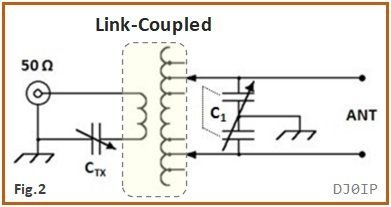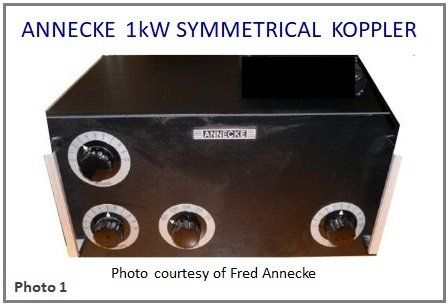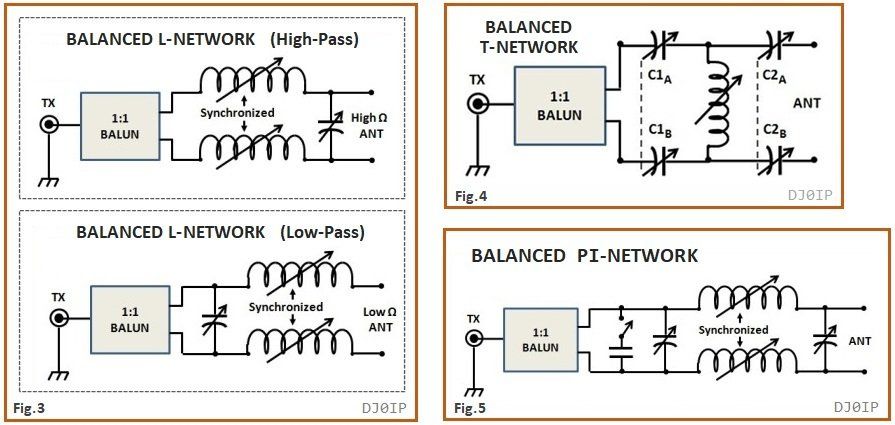MATCHING BALANCED-LINE-FED ANTENNAS
(This is the Land of Confusion)
In various books and online groups we can read different opinions on how to best match antennas fed with balanced-line (a.k.a. "openwire", "window-line", "ladder-line") transmission line.
This is indeed confusing.
Part of the confusion is due to the difference in different types of antennas. What's good for one antenna, may not be good for another antenna.
Before we begin to choose a matching circuit, we must first understand what "balanced" means when working with balanced-line-fed antennas.

When we think of a balanced antenna, many people believe we are referring to the physical construction of the antenna. In Figures 1A and 1B above, both antennas are symmetrical with respect to the feedline.
However, with respect to ground, Fig.1A is fairly well balanced, while Fig.1B clearly is not.
As a result, we can expect to have a lot more Common Mode Current (CMC) on the feedline of the
Vertical Dipole than on the feedline of the Horizontal Dipole.
Common Mode Current can cause many problems and should be eliminated as best as possible.
(See:
Common Mode Current )
BLANCED ANTENNA MATCHBOX
As long as I have been a ham (60+ years), it has been claimed that the best way to match a balanced-line-fed antenna is with a balanced matchbox. In the 1960s, a balanced matchbox was typically a link-coupled matchbox. It was claimed that a link-coupled matchbox had 20dB more suppression of Common Mode Current than other circuits. I do not know if that is true, however, having used both of the matchboxes shown in photos 1 & 2 (below) with several different balanced-line-fed antennas (and high power), I can say that I never had any issues with RF in the shack.



Figure 2 shows a typical link-coupled antenna matchbox schematic. Grounding between the two capacitors is optional. The Johnson Viking Matchbox and ANNECKE Symmetrical Coupler are no longer in production.
To my knowledge, no commercial manufacturer is currently building link-coupled antenna tuners. The circuit above is over-simplified. The two matchboxes shown use double-differential variable capacitors. These are dreadfully expensive today - if you can even find them. In addition, the link coupled coils must be custom-made. I doubt anyone will ever build these commercially.
CURRENT BALANCED ANTENNA MATCHBOX CIRCUITS
In the past few decades, newer balanced matchbox designs have become available. Though not link-coupled, they are true balanced tuners. These are shown in figures 3, 4, & 5 below:

The advantage these newer matchboxes have over traditional Link-Coupled matchboxes is, they are built using standard components, readily available in the industry. The disadvantage is, they are more expensive than an unbalanced L-Network or the popular unbalanced T-Network matchboxes.
Here are the current products:
- A Balanced L-Network matchbox is available from Palstar: AT-1500B
- Two Balanced T-Network matchboxes are available from MFJ: MFJ-984 & MFJ-986.
- Until recently, there were two companies offering Balanced PI-Network matchboxes. Unfortunately, both companies are out of business now, due to the death of their owners:
- HamWare AT-615 (in Germany)
- PA0LL Symmetrical-Pi Tuner (in Holland)
MATCHING ALTERNATIVES
As a result of true balanced matchboxes being rare and expensive, an alternate means of matching balanced-line-fed antennas was needed. A simple solution was found, using a standard unbalanced antenna matchbox together with a balun on its output (antenna) side.
At first, the tuner manufacturers used a 4:1 Ruthroff (voltage) balun for this. Although it worked, it often had common mode current issues, and had problems matching low impedance loads. After Roy LeWallen (W7EL) published is paper
Baluns: What They Do And How They Do It, the industry began switching to Guanella (current) baluns. Unfortunately, some kept the 4:1 balun ratio. This was a mistake.
Tuner Balun: A tuner balun (for unbalanced matchboxes) must be a 1:1 Guanella (current) balun. This is explained in detail by W8JI and G3TXQ (SK),
HERE. (links at the bottom of that page)
Where does the Tuner Balun go? On the input (TX) side or the output (ANT) side?
The balun must be connected between the output of the matchbox and the balanced feedline.
SOURCE OF CONFUSION: True Balanced Matchbox vs. Unbalanced Matchbox + Balun.
In a recent Facebook group discussion on this topic, one OM was insisting the balun goes on the input side of the matchbox, I was insisting it goes on the output side of the matchbox.
Both of us were right.
While I was referring to an unbalanced matchbox, the other OM was referring to a true balanced matchbox.
When discussing this topics with others, be sure you are both thinking of the same type of matchbox!
HOW WELL DOES AN UNBALANCED MATCHBOX + BALUN WORK?
Assuming you are using the correct balun design, attached to the output (ANT) side of the matchbox, for all practical purpose, this will work just as well as a true balanced matchbox.
Many OM (especially Old Timers) will argue this point, based on their recollection of history, or what they may have read somewhere. History was mostly based on Link-Coupled antenna matchboxes.
The efficiency and quality of a matchbox when matching balanced-line-fed antennas is determined by three factors:
1) The amount of RF current asserted on the feedline
2) The balance of RF current asserted onto each of the two wires. They should be equal.
3) The phase of the RF current asserted onto each of the two wires. Again, they should be equal.
Determining this is a monumental task, and beyond the capability of most hams.
However, in recent years, several OM have performed tests on a multitude of different antenna matchboxes. The results of 4 of these tests are published on my web site. They are Matchbox Shootout numbers 2, 3, 4 and 5, HERE:
THE BOTTOM LINE: In all four of the Matchbox Shootouts matching balanced-line-fed antennas, true balanced matchboxes failed to outperform some of the matchboxes using a good balun on their output.
However, you can't just use any old unbalanced matchbox. It must be a matchbox with a broad impedance matching range. In addition, the balun must be a 1:1 Guanella (current) balun and preferably mounted external to the matchbox in a non-metallic enclosure (or not enclosure at all).
I WELCOME FEEDBACK ON EXPERIENCE WITH LESS-THAN-PERFECT ANTENNAS,
matched with any of these new true balanced matchboxes.
Now let's look at the two antennas in Figure 1A and 1B above.
Fig.1A: In most cases, there will not be much trouble with the horizontal dipole. There should be relatively little common mode current on the feedline, and any of the matching solutions listed above will work just fine.
Fig.1B: This antenna has common mode current on the feedline. When running high power (i.e., 1kW), there can be quite a lot of common mode current. Although I never had any problem when running the big ANNECKE 1kW symmetrical coupler, I had serious problems running various unbalanced matchboxes with several different high power commercial baluns. Some were 4:1 voltage baluns, others were 4:1 current baluns, but wound onto a single core. (This was 20+ year ago before I began studying balun technology).
Through a tip from a good friend, I threw out all of my commercial 4:1 baluns and built a 1:1 current balun. NO MORE PROBLEMS!
Based on lots of experience running 1kW into multiple antennas, I know for a fact that:
- The Link-Coupled ANNECKE works great without problems.
- That several T-Network and L-Network matchboxes (i.e., Palstar AT3K and a high power home brew T-Network, as well as a Ten-Tec 238B L-Network) work fine, no problems, when using an external 1:1 current balun between the feedline and the matchbox.
What I do not know:
- If any of modern true balanced matchboxes will work with the Vertical-Dipole?
- If they do not work, or have problems, will a Maxwell choke on the TX side of the matchbox be sufficient to block the common mode current, or would a Guanella choke-balun be required?
